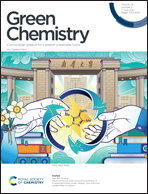Biomass-derived γ-valerolactone: efficient dissolution and accelerated alkaline hydrolysis of polyethylene terephthalate
Abstract
The vast increase in the use of post-consumer polyethylene terephthalate (PET) plastic brings with it the challenge of recycling the increase in waste bottles and materials. The degradation of waste PET to its monomers in an environmentally benign solvent is a desirable way to process waste PET. Analysis of solubility parameters has inspired the successful application of biomass-derived γ-valerolactone (GVL) for PET dissolution, and further accelerated the alkaline hydrolysis of waste PET to its monomers. Hydrogen-bonding interactions between PET chains and GVL play a major role in the dissolution. Swelling differential scanning calorimetry (DSC) has indicated that GVL processing PET proceeds through two steps: swelling and dissolving. The optimal dissolving process by swelling DSC showed that waste PET bottle pieces could fully swell at 120 °C in 1 h, then dissolve at 170 °C in 2 min. The maximum solubility of PET in GVL is around 0.25 g·g−1. Here, water was used as an anti-solvent to induce PET to reprecipitate from the hot solution. Due to the virtue of fully pre-swelling and the very fast dissolution, the degradation ratio of PET during the dissolving process was only 5.7%. GVL processing greatly increased the effective surface area of PET, which promoted the following complete alkaline hydrolysis of PET in around 8 min. This study provides an environmentally benign, very fast, and energy efficient pathway for recycling waste PET.



 Please wait while we load your content...
Please wait while we load your content...